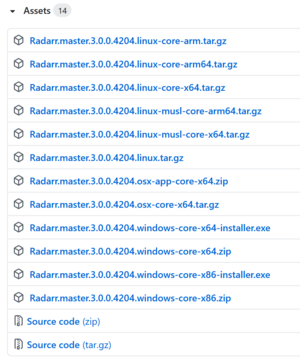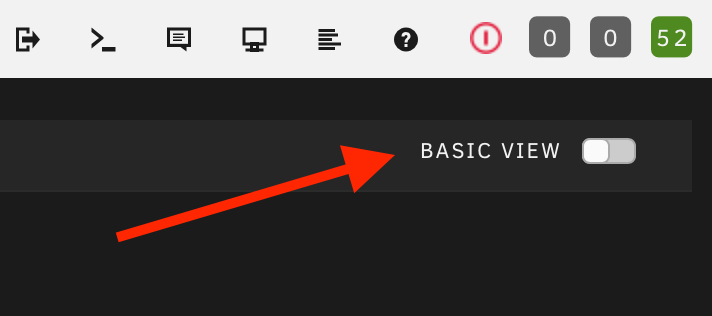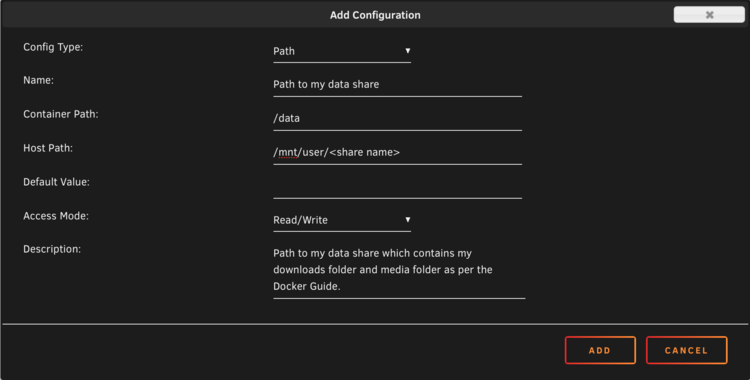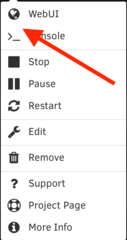Difference between revisions of "Template:Installation"
(→Linux) |
|||
| Line 128: | Line 128: | ||
Download this file onto your system: | Download this file onto your system: | ||
| + | {{{ArrDownloadLink}}} | ||
| − | Radarr: | + | Radarr: |
wget --content-disposition 'http://radarr.servarr.com/v1/update/master/updatefile?os=linux&runtime=netcore&arch=x64' | wget --content-disposition 'http://radarr.servarr.com/v1/update/master/updatefile?os=linux&runtime=netcore&arch=x64' | ||
Uncompress: | Uncompress: | ||
Revision as of 17:39, 2 December 2020
This template is expressly for the steps and processes of installing all the various ARR software on multiple different platforms
| Parameter | Description | Type | Status | |
|---|---|---|---|---|
| ARRNAME | ARRNAME | Name of the ARR
| String | required |
| RunArrCommandLinux | RunArrCommandLinux | Command to Start & Run ARR Linux
| String | required |
| RunArrCommandOSX | RunArrCommandOSX | Command to Start & Run ARR OSX
| String | required |
| ArrExecutableNameWin | ArrExecutableNameWin | Executable Name for Windows
| String | required |
| ArrDownloadLink | ArrDownloadLink | Link to the Arr Downloads | URL | required |
| ArrLinuxAutoStart | ArrLinuxAutoStart | Autostart file instructions | Unknown | required |
| ARRPORT | ARRPORT | Port number for the ARR
| Number | required |
| ARRNAME2 | ARRNAME2 | Used for lowercase ARR names, this is not a required field only used if needed
| String | optional |
Installing
Windows
OSX
Linux
Debian / Ubuntu
Most of the "arr" software runs on mono, however newer version may run on .NET Core. If a .NET Core version is available, it will likely offer significant speed and resource enhancements.
Mono Install
Some "arr" software supports repository based automatic installs, and some must be installed manually. Repository installs will typically automatically install needed dependencies.
Repository Install
Sonarr:
sudo apt-key adv --keyserver keyserver.ubuntu.com --recv-keys 0xA236C58F409091A18ACA53CBEBFF6B99D9B78493 echo "deb http://apt.sonarr.tv/ master main" | sudo tee /etc/apt/sources.list.d/sonarr.list sudo apt update sudo apt install nzbdrone
To start Sonarr, you need to call the mono executable:
/usr/bin/mono --debug /opt/NzbDrone/NzbDrone.exe
Manual Install
First start by installing the dependencies:
Mono:
sudo apt-key adv --keyserver hkp://keyserver.ubuntu.com:80 --recv-keys FA7E0328081BFF6A14DA29AA6A19B38D3D831EF echo "deb https://download.mono-project.com/repo/ubuntu stable-focal main" | sudo tee /etc/apt/sources.list.d/mono-official-stable.list sudo apt update && sudo apt install mono-devel
Curl
sudo apt install curl
Mediainfo:
sudo apt install mediainfo
sqlite3:
sudo apt install sqlite3
Now download the newest mono version release of {{{ARRNAME}}}:
wget --content-disposition '{{{ARRPackageFileMono}}}'
Uncompress:
tar -xvzf {{{ARRNAME}}}*.tar.gz
Move to your preferred install location (typically /opt/{{{ARRNAME}}}/
sudo mv {{{ARRNAME}}}/ /opt
Finally, make sure you grant the needed permission to your install directory:
sudo chown {{{ARRNAME2}}}:{{{ARRNAME2}}} /opt/{{{ARRNAME}}}
You can start {{{ARRNAME}}} with the following command:
/usr/bin/mono --debug /opt/{{{ARRNAME}}}/{{{ARRNAME}}}.exe -nobrowser
.NET Core Install
There are no dependencies needed for the .NET Core Install path.
Manual Install
Go to the {{{ARRNAME}}} download page, and pick the appropriate file. Note that only Radarr currently has a .NET Core install path right now.
In the example screenshot here, you can see multiple options. Choose the option that matches your OS and processor best. For most users, this would be .linux-core-x64.tar.gz if it is available.
Download this file onto your system: {{{ArrDownloadLink}}}
Radarr:
wget --content-disposition 'http://radarr.servarr.com/v1/update/master/updatefile?os=linux&runtime=netcore&arch=x64'
Uncompress:
tar -xvzf {{{ARRNAME}}}*.linux-core-x64.tar.gz
Move to your preferred install location (typically /opt/{{{ARRNAME}}}/
sudo mv {{{ARRNAME}}}/ /opt
Finally, make sure you grant the needed permission to your install directory:
sudo chown {{{ARRNAME2}}}:{{{ARRNAME2}}} /opt/{{{ARRNAME}}}
You can start {{{ARRNAME}}} with the following command:
/opt/{{{ARRNAME}}}/{{{ARRNAME}}} -nobrowser
Auto Start Using Systemd
Most modern Linux distributions have switched to systemd, which involves a simple unit service file which gets enabled and started. It is important to remember that in Linux, capitalization matters. User account names and Group names are typically all lowercase, as are the directory structures mapped to them as part of the home directory.
Preparing the Unit Service File
Several items may need to be changed to match your installation:
Usershould match the service account that {{{ARRNAME2}}} will run as.Groupshould match the service account group that {{{ARRNAME2}}} will run as.ExecStarthas several items that should match your installation/opt/{{{ARRNAME}}}/{{{ARRNAME}}}- Executable Path Default location is
/opt/{{{ARRNAME}}}/{{{ARRNAME}}}, but you may need to update if you installed {{{ARRNAME}}} elsewhere. - Data Directory Default location is
-data=/home/{{{ARRNAME2}}}/.config/{{{ARRNAME}}}/, but you may need to update if you want to keep your database and settings elsewhere. - Mono Path (if Mono is being used) Default location is
/usr/bin/mono, but you may need to update if you installed Mono elsewhere.
- Executable Path Default location is
The unit service file should be named {{{ARRNAME}}}.service and the best place for it is /etc/systemd/system/. Alternative locations like /usr/lib/systemd/system/ and /lib/systemd/system/ may depend on the distribution used.
This example unit assumes that the User and Group are both {{{ARRNAME2}}}, {{{ARRNAME}}}'s executable is placed in /opt/{{{ARRNAME}}}/, the data directory is placed in /home/{{{ARRNAME2}}}/.config/{{{ARRNAME}}}, and the Mono executable (if being used) is placed in /usr/bin/mono.
Important note: Both ExecStart lines are commented out below. Remove the # from the line matching your install type (Mono vs NetCore).
[Unit]
Description={{{ARRNAME}}} Daemon
After=syslog.target network.target
[Service]
# Change the user and group variables here.
User={{{ARRNAME2}}}
Group={{{ARRNAME2}}}
Type=simple
# NOTE: Uncomment one of the two below ExecStart lines, based on if {{{ARRNAME}}} is using NetCore or Mono.
# NetCore install:
#ExecStart=/opt/{{{ARRNAME}}}/{{{ARRNAME}}} -nobrowser -data=/home/{{{ARRNAME2}}}/.config/{{{ARRNAME}}}/
# Mono Install:
#ExecStart=/usr/bin/mono --debug /opt/{{{ARRNAME}}}/{{{ARRNAME}}}.exe -nobrowser -data=/home/{{{ARRNAME2}}}/.config/{{{ARRNAME}}}/
TimeoutStopSec=20
KillMode=process
Restart=on-failure
[Install]
WantedBy=multi-user.target
Verify Directory Permissions
Ensure the User that will be running {{{ARRNAME}}} has access to both the executable directory and data directory.
Running the command ls -lad /directory/ will show the permissions for that folder.
Example:
$ ls -lad /opt/{{{ARRNAME}}}
drwxr-xr-x 6 {{{ARRNAME2}}} {{{ARRNAME2}}} 24576 Nov 28 21:30 /opt/{{{ARRNAME}}}/
$ ls -lad /home/{{{ARRNAME2}}}/.config/{{{ARRNAME}}}/
drwxr-xr-x 6 {{{ARRNAME2}}} {{{ARRNAME2}}} 24576 Nov 28 21:30 /home/{{{ARRNAME2}}}/.config/{{{ARRNAME}}}/
Enabling and starting the Unit Service File
Once you have created {{{ARRNAME}}}.service, you will want to enable the service:
sudo systemctl enable {{{ARRNAME}}}.service
You are now ready to start {{{ARRNAME}}}. You can do so with the start command:
sudo systemctl start {{{ARRNAME}}}.service
If you want to verify {{{ARRNAME}}} is running, you can run the status command:
$ sudo systemctl status {{{ARRNAME}}}.service
● {{{ARRNAME}}}.service - {{{ARRNAME}}}Service
Loaded: loaded (/usr/lib/systemd/system/{{{ARRNAME}}}.service; enabled; vendor preset: disabled)
Active: active (running) since Tue 2017-03-07 10:23:44 PST; 5min ago
Main PID: 19978 ({{{ARRNAME}}})
Tasks: 16 (limit: 4915)
Memory: 114.6M
CPU: 9.331s
CGroup: /system.slice/{{{ARRNAME}}}.service
└─19978 /opt/{{{ARRNAME}}}/{{{ARRNAME}}} -nobrowser -data=/home/{{{ARRNAME2}}}/.config/{{{ARRNAME}}}/
Mar 07 10:23:44 apollo systemd[1]: Started {{{ARRNAME}}} Service.
NAS
FreeNAS
Qnap
Synology
Docker
Docker on unRAID
- Installation of {{{ARRNAME}}} is quite simple when it comes to unRAID as they have made installing Docker containers a breeze.
Simply head on over to the community applications store on the top bar of your browser.
In the search field type in {{{ARRNAME}}}
Select which docker image you would like to install. There are several to choose from
Depending on which container you go with will determine the steps in which you take. Some containers come preloaded with volumes mapped already. This is really up to your liking how you would like your container volumes to be laid out. It is highly recommended to follow the guide listed here for your volume mapping
Once you have selected which container you are going to go with, you will need to either create the volumes for {{{ARRNAME}}} to be able to use or simply use the pre-filled ones. (Highly recommended to remove the pre-filled and use your own, to remove the pre-filled ones).
To create new volumes simply select the
Add another Path, Port, Variable, Label or Devicetext at the bottom above the Apply button.
Once the new window appears you will want to use the drop down box next to Config Type: and make sure that it is set to Path.
From here you will want to fill out all pertinant information:
Name: The name of this path, this can be any unique name more like a note to know what this path is for.
Container Path: This will be the path that {{{ARRNAME}}} will see inside the container
/datais a favorite
Host Path: This is the path to the host (unRAID) machine, This will be
/mnt/user/<Your User Share>
The last three items Default Value:, Access Mode", and Description: Can be left alone.
Click ADD
Last thing to check is to make sure Host Port for {{{ARRPORT}}} is filled in with
{{{ARRPORT}}}, UNLESS This port causes any conflicts with any other container. If it does please choose a different port that is not in use.
Click APPLY
Now the {{{ARRNAME}}}'s container is being downloaded, once complete simply click the OK button at the bottom of the new pop up window
Click DOCKER on the top row of your browser.
Now all you will need to do is simply left click on your newly created container and select WebUI.
Now a new browser tab should show up with {{{ARRNAME}}} running in all its glory. ENJOY
[[File:{{{ARRNAME}}}-unraid-install.png|frameless|none|750px|alt=Installation Options|Installation Options]]
Depending on which container you select you may recieve a pop up asking you to Choose A Branch To Install when in doubt go with the Default :latest branch
To remove the pre-filled paths simply select the toggle in the upper right from Basic to Advanced view then scroll down to the pre-filled path and click Remove
NOTE If you follow the Docker Guide you will only need one Volume path to be made as all information that {{{ARRNAME}}} will need will be in one share /mnt/user/data




